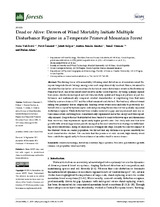Mostrar el registro sencillo del ítem
Dead or Alive: Drivers of Wind Mortality Initiate Multiple Disturbance Regime in a Temperate Primeval Mountain Forest
| dc.contributor.author | Vašíčková, Ivana | |
| dc.contributor.author | Šamonil, Pavel | |
| dc.contributor.author | Kašpar, Jakub | |
| dc.contributor.author | Román Sánchez, Andrea | |
| dc.contributor.author | Chuman, Tomáš | |
| dc.contributor.author | Adam, Dušan | |
| dc.date.accessioned | 2021-11-22T07:55:41Z | |
| dc.date.available | 2021-11-22T07:55:41Z | |
| dc.date.issued | 2021 | |
| dc.identifier.uri | http://hdl.handle.net/10396/22157 | |
| dc.description.abstract | The driving forces of tree mortality following wind disturbances of mountain mixed European temperate forests belongs among issues not comprehensively resolved. Hence, we aimed to elucidate the key factors of tree resistance to historical severe disturbance events in the Boubínský Primeval Forest, one of the oldest forest reserves in the Czech Republic. By using spatially explicit tree census, dendrochronological and soil data, we study spatial and temporal patterns of past disturbances and mathematically compared selected characteristics of neighboring trees that were killed by a severe storm in 2017 and those that remained undisturbed. The tendency of trees toward falling was primarily driven edaphically, limiting severe events non-randomly to previously disturbed sites occupied by hydromorphic soils and promoting the existence of two spatially-separated disturbance regimes. While disturbed trees usually recruited in gaps and experienced only one severe release event, surviving trees characteristically regenerated under the canopy and were repeatedly released. Despite the fact that disturbed trees tended to reach both lower ages and dimensions than survivors, they experienced significantly higher growth rates. Our study indicates that slow growth with several suppression periods emerged as the most effective tree strategy for withstanding severe windstorms, dying of senescence in overaged life stage. Despite the selective impact of the Herwart storm on conifer population, we did not find any difference in species sensitivity for most characteristics studied. We conclude that the presence of such ancient, high-density wood trees contributes significantly to the resistance of an entire stand to severe storms. | es_ES |
| dc.format.mimetype | application/pdf | es_ES |
| dc.language.iso | eng | es_ES |
| dc.publisher | MDPI | es_ES |
| dc.rights | https://creativecommons.org/licenses/by/4.0/ | es_ES |
| dc.source | Forests 12(11), 1599 (2021) | es_ES |
| dc.subject | Dendrochronology | es_ES |
| dc.subject | Disturbance history | es_ES |
| dc.subject | Fagus sylvatica | es_ES |
| dc.subject | Picea abies | es_ES |
| dc.subject | Geostatistics | es_ES |
| dc.subject | Growth release | es_ES |
| dc.subject | Soil properties | es_ES |
| dc.subject | Wind mortality | es_ES |
| dc.title | Dead or Alive: Drivers of Wind Mortality Initiate Multiple Disturbance Regime in a Temperate Primeval Mountain Forest | es_ES |
| dc.type | info:eu-repo/semantics/article | es_ES |
| dc.relation.publisherversion | https://doi.org/10.3390/f12111599 | es_ES |
| dc.rights.accessRights | info:eu-repo/semantics/openAccess | es_ES |

